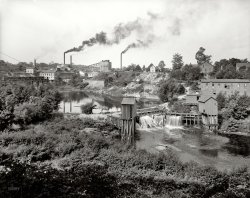
MAY CONTAIN NUTS

Search Shorpy
SHORPY ART

Framed or unframed, desk size to sofa size, printed by us in Arizona and Alabama since 2007. Explore now.
Join and Share
Ad-Free Shorpy
Shorpy is funded by you. Patreon contributors get an ad-free experience.
Learn more.

Recent comments
- If You’re Like Me, Never
- U.S.A.
- S&P
- 1940 Zenith radio model 6G601
- Quality goes in before the name goes on!
- Snazzy skirt
- Carbon Arc Lamps
- Illuminate us
- I remember it well
- I can't prove it
- Complicated then, forgotten now
- Bryan-Stevenson
- Skinny is as skinny does
- How do you rest in peace
- Riding the footboards
- Alas, hidden from view
- Baldwin Diesels
- Exclusive pump
- Bananas, Oysters and Smokey Joe
- Details, Details
- What's that building to the left of the tower?
- Coal Barges
- Bromo-Seltzer
- Inner harbor
- The Basin
- What a headache!
- Giant stepladder?
- Yeah, it was cold
- Love those coats
- Link & Pin Days Remnant
Member Photos
The Shorpy
Print Emporium
Print Emporium
Search Shorpy
Search results -- 30 results per page
- Postal Kingdom: 1905
- Circa 1905. "Post office, Saginaw, Michigan." Perhaps our most Disneyesque P.O. so far. 8x10 inch glass negative, ... Posted by Dave - 07/19/2012 - 10:24pm -
![Postal Kingdom: 1905 Circa 1905. "Post office, Saginaw, Michigan." Perhaps our most Disneyesque P.O. so far. 8x10 inch glass negative, Detroit Publishing Company. View full size.
Workers' ParadiseI probably wouldn't have retired if I'd been working in that one. Not sure they would have gone for my spending my time making dioramas, though.
Memorial FlagCan anyone make out the sign?
["Navy Recruiting Station Permanently Located" - tterrace]
Thank You Saginaw!I was there a few years ago for a wedding but don't recall seeing the old post office. Here's a picture of it still going strong however!
Castle MuseumThe post office left the building long ago. It is now known as the Castle Museum and is the home of the Saginaw Historical Society.
AwningsI love the canvas awnings.
FinialsThere is much to admire about this old building. But, my favorites are the metal finials at the high points of the building. They are probably forged from copper.
Visited TodayWe visited the building today thanks to Shorpy. It is just as interesting on the inside as the outside. The tall tower has an incredible sprial staircase running up the outside wall. The main lobby is excellent too. Up in the attic space is a long narrow runway with peep holes to the floor spaces below so that inspectors could keep watch on the employees as they worked behind the counters and in the sorting rooms! A major addition in 1930 on the back of the building doubled it's size and was done so well you can't tell where the original building leaves off and the addition starts. The museum is excellent and the staff are very friendly. Highly recommended if you are ever in the area!
(The Gallery, DPC)](https://www.shorpy.com/files/images/SHORPY_4a22443a.thumbnail.jpg)
- Capitalist Tools: 1901
- Chelsea, Michigan, circa 1901. "Glazier Stove Company, machine room." 8x10 inch dry ... Posted by Dave - 03/05/2017 - 9:02pm -
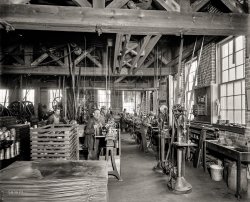
- Boy, Bike, Boat: 1906
- ... River circa 1906. Steamer Tashmoo at St. Clair Flats, Michigan." 8x10 inch dry plate glass negative, Detroit Publishing Company. ... Posted by Dave - 10/08/2014 - 6:11pm -
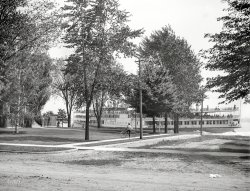
- Peoples Gas Light & Coke: 1912
- Chicago circa 1912. "Peoples Gas Company Building, Michigan Avenue." 8x10 inch dry plate glass negative, Detroit Publishing ... Posted by Dave - 01/07/2021 - 3:08pm -
![Peoples Gas Light & Coke: 1912 Chicago circa 1912. "Peoples Gas Company Building, Michigan Avenue." 8x10 inch dry plate glass negative, Detroit Publishing Company. View full size.
+105Below is the same view from June of 2017.
Horse of a different colorEither the gas company did an architecturally sensitive addition, or the difference in color on the front of the building indicates that it is undergoing a much-needed cleaning.
[It was built in two phases. - Dave]
If a cake were a buildingAcross the street from the Art Institute. Luscious architecture. There's a Walgreens in the ground floor where I bought a Coke on a scorching day in August of 2018 after a visit to the galleries.
The TrioI'm surprised that the two smaller buildings to the right are still there. The one farthest to the right has some more floors added on top but they left the bric-a-brac that was at the top in 1912 as part of the newer facade.
[Both of those smaller buildings have had floors added. - Dave]
The Missing CorniceThis photograph shows the exuberant original cornice that once crowned this building - now sadly truncated, as seen in the contemporary photo. Persistent rumors tell of a municipal ordinance that required building owners to remove projecting cornices from downtown Chicago buildings sometime in the late 1940s. The Chicago History Museum collection has a picture of this operation being performed on the Marshall Field Department Store dated November 25, 1947. While some notable Chicago landmarks (the Reliance Building, the Carson Pirie Scott Store) have had their cornices restored in facsimile form in recent years, this one and so many others are still sadly shorn off at the top. What a terrible shame!
[If you want your noggin bashed in by falling masonry. - Dave]
2017 ImageThat is a beautiful photo, Timeandagainphoto.
Re: 2017 ImageThank you very much Sayles.
(The Gallery, Chicago, DPC)](https://www.shorpy.com/files/images/SHORPY-4a19982a.thumbnail.jpg)
- City of Mackinac: 1905
- ... Circa 1905. "D.& C. steamer at dock, St. Ignace, Michigan." The Detroit & Cleveland Navigation Company's City of Mackinac ... Posted by Dave - 07/22/2019 - 3:45pm -
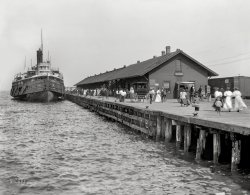
- The Stamp Mill: 1906
- ... compound pump, Calumet and Hecla stamp mill, Lake Linden, Michigan." Note the faint double exposure in this 8x10 inch glass plate. ... Posted by Dave - 07/28/2013 - 10:16pm -
![The Stamp Mill: 1906 Copper production circa 1906. "12,000 horsepower compound pump, Calumet and Hecla stamp mill, Lake Linden, Michigan." Note the faint double exposure in this 8x10 inch glass plate. Detroit Publishing Company. View full size.
Enter Charlie ChaplinLooks like the movie Modern Times could have been shot there.
The Main Bearingmust have required constant attention as evidenced by the captain's chair on the platform. Employees of the era were rarely offered the opportunity to sit while on the job.
It brings to mind a John Lennon lyric from a 1980 song "I'm just sittin' here watching the wheels go round and round, I really love to watch them roll."
The steam engine is a work of art but so, too, is the building with its myriad girder and truss work. Note the sloping outer walls fit to the angle bracing and that huge overhead hoist! Another fascinating Shorpy view!
Sitting roomI found two other chairs, just to the right of the big wheel, one on the top platform and one on the bottom.
Domestic plumbingApparently they are pumping houses through that big pipe.
[The houses are an exact match for another Shorpy image -- who'll be the first to find it? - Dave]
The First Exposure or the Second?I propose The Heart of Copper Country: 1905 as the second exposure on the above photo.
[We have a winner. -tterrace]
Way ta go!Congrats to Orange56! Good eye!
CraneCan anyone make out the manufactures sign on the Overhead crane? Thanks in advance
(Technology, The Gallery, DPC, Mining)](https://www.shorpy.com/files/images/SHORPY_4a13097a.thumbnail.jpg)
- Badger State Fur: 1901
- ... I'm one bridge too close. I should have been on the West Michigan Street Bridge. It makes little difference -- more modern buildings ... Posted by Dave - 01/18/2021 - 10:26pm -
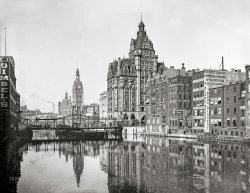
- Hotel Gus: 1905
- St. Clair Flats, Michigan, circa 1905. "Resort sightseers on dock of Gus. Trautz's Hotel." 8x10 ... Posted by Dave - 09/12/2012 - 10:38am -
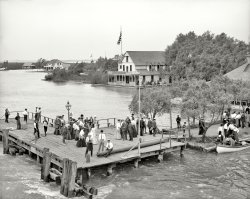
- Flying Boat: 1900
- October 13, 1900. Wyandotte, Michigan. "Launch of fire boat James Battle." 8x10 inch dry plate glass ... Posted by Dave - 08/13/2012 - 9:14pm -
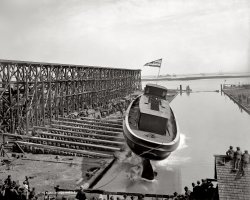
- Owana at Toledo: 1912
- ... in 1889 by Detroit Dry Dock Company, Wyandotte, Michigan. Renamed Owana in 1905, Erie in 1925, T. A. Ivey in 1934, ... of New York , 1883.
Sidewheeler railroad ferry Michigan Central , 1884.
Sidewheeler Frank E. Kirby , 1890.
Fire ... Posted by Dave - 10/29/2012 - 10:42pm -
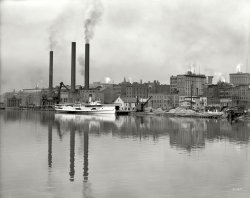
- Grand Rapids Chair: 1908
- Circa 1908. "Grand Rapids Chair Co., Grand Rapids, Michigan." 8x10 inch dry plate glass negative, Detroit Publishing Company. ... Posted by Dave - 08/21/2012 - 5:19pm -
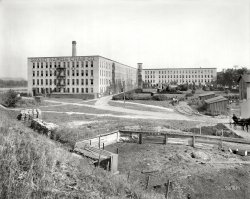
- S.S. Utica: 1910
- ... aware a vessel of this size could move South out of Lake Michigan and down thru to New Orleans in the canal/river system.
[As ... Posted by Dave - 08/14/2012 - 8:50pm -
![S.S. Utica: 1910 Circa 1910. "Freighter S.S. Utica, New York Central and Hudson River Railroad Line." 8x10 inch glass negative, Detroit Publishing Company. View full size.
1904-1949Constructed by the Detroit Ship Building Co., this 325-foot package freighter was launched April 28, 1904, at Wyandotte for the Western Transit Company, the marine operation of the New York Central on the Great Lakes.
In 1915 the Interstate Commerce Commission, citing the 1912 Panama Canal Act, ruled that American railroads could not also engage in marine transportation, and the NYC (as well as Erie, Pennsylvania, and Lehigh Valley) sold their steamship operations on the Great Lakes. Many of the vessels were consolidated under a new firm, Great Lakes Transit Corporation, for which the Utica ran from 1916 until 1945. That year, GLTC sold her to Chilean interests who renamed her Quintay. She was towed down the Chicago River, the Chicago Sanitary and Ship Canal, the Illinois River, and eventually the Mississippi to New Orleans.
The Quintay stranded and became a total loss on Penguin Island in the Messier Channel, Chile, on April 28, 1949, on a voyage from Callao to Punta Arenas while carrying general cargo and drums of oil.
Steamship Utica
Beeson's Marine Directory of the Northwestern Lakes, 1908
Steamship Utica, built in 1904 for the Western Transit Co. of Buffalo, N.Y. Gross tonnage: 3533, length: 325 ft., beam: 44 ft.
HmmmmI wonder what the three planks on the side of the hull are.
[Docking fenders. - Dave]
Rounding the Eastern Continent?I was not aware a vessel of this size could move South out of Lake Michigan and down thru to New Orleans in the canal/river system.
[As noted below, the Utica was a Great Lakes freighter. - Dave]
(The Gallery, Boats & Bridges, DPC)](https://www.shorpy.com/files/images/4a16007a.thumbnail.jpg)
- Lever of Power: 1942
- ... N.A. Woodworth Co. (later ITW Workholding) in Ferndale, Michigan. A short article about Woodworth and the 50 "girls" that worked there ... Posted by Dave - 04/27/2015 - 7:22am -
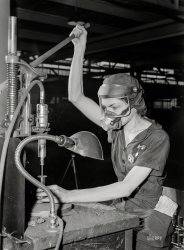
- Going Down: 1908
- Sault Sainte Marie, Michigan, circa 1908. "Diver repairing a lock gate." Detroit Publishing Company ... Posted by Dave - 08/21/2012 - 8:37pm -
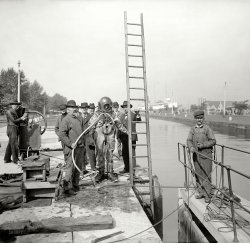
- The Club: 1900
- Huron County, Michigan, circa 1900. "Dining room at the Club, Pointe aux Barques." 8x10 inch ... Posted by Dave - 08/02/2012 - 4:14pm -
![The Club: 1900 Huron County, Michigan, circa 1900. "Dining room at the Club, Pointe aux Barques." 8x10 inch glass negative, Detroit Publishing Company. View full size.
Health and SafetyDon't you love that wiring? Health and Safety would have a field day with wires strung across a wooden ceiling and tapped into for every light.
Elegant DiningWould really like to have a meal here. Imagine of the ambiance.
Into the WoodsWood floors, wood beams, wood ceilings, wood walls, wood doors, even wood tables and wood chairs. Does anyone want to lay odds on how long before the whole place burns to ashes?
Rustic to a FaultThe bare light bulbs hanging down from the ceiling along with the split beams and supports. Only thing missing is peanut shells on the floor.
Look at all those chairs!Do you think they came from the Grand Rapids Chair Company?
HornsI wonder who put those horns up on the rafters top left. There is nothing else attached to the rafters anywhere. Just the solitary horns.
[That's a metal bracket. With a string attached. - Dave]
GorgeousI'll bet all that knotty pine and/or cedar positively glowed when the window shades were up. That wiring was safe enough when it was brand new, given a few years of wear and tear, somewhat less so.
(The Gallery, DPC, Eateries & Bars)](https://www.shorpy.com/files/images/SHORPY_4a07910a.thumbnail.jpg)
- Calumet and Hecla: 1905
- ... Circa 1905. "Calumet and Hecla smelters, Lake Linden, Michigan." Starting point for the web of copper telephone and streetcar wires ... Posted by Dave - 06/17/2013 - 1:09pm -
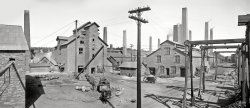
- Ladies Who Launch: 1913
- March 8, 1913. Wyandotte, Michigan. "Steamers A.D. MacTier and F.P. Jones , sponsors." 8x10 inch ... she sank in a storm carrying grain from Ontario to Michigan. It broke apart when a hatch cover gave way and the grain got wet. As ... Posted by Dave - 10/05/2016 - 1:45pm -
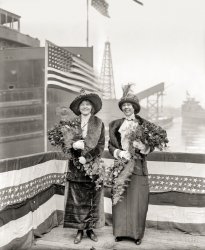
- Cuyahoga Lift Bridge: 1910
- ... Tempest, built 1876 by Duncan Robertson at Grand Haven, Michigan. It burned at Parry Sound, Ontario, on June 28, 1909. On the right ... Posted by Dave - 10/13/2018 - 10:36am -

- Ground Rules: 1900
- Circa 1900. "Golf links at Charlevoix, Michigan." Mind if we play through? 8x10 inch dry plate glass negative, Detroit ... Posted by Dave - 03/26/2013 - 7:27pm -
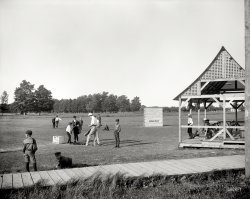
- Along the River: 1905
- ... and Chicago, Ill. The steamer called at Cleveland, Ohio, Detroit, Mackinac Island, Harbor Springs, and Milwaukee, Wis.
With her ... operate the North Land in 1917 under lease to the Northern Michigan Transportation Company failed to materialize.
In 1918 the North ... Posted by Dave - 12/12/2012 - 1:03pm -
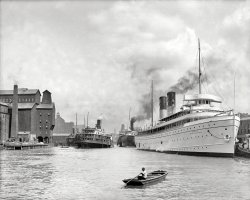
- Friday's Child: 1905
- ... 1985 and is interred at Forest Hill Cemetery in Ann Arbor, Michigan.
Mutually exclusive Bow or hat. I don't see how you could wear ... Posted by Dave - 01/06/2017 - 12:12pm -
![Friday's Child: 1905 "Durant, Mrs. T. (child) -- between March 1905 and August 1906." 5x7 glass negative from the C.M. Bell portrait studio in Washington, D.C. View full size.
Society's ChildFather is probably Thomas Durant, a patent lawyer and husband of Mary. The daughter shown here would be Maxine, who was 11 years old in the 1910 Census. She will marry Lorenzo Dale Burnell, a CPA, in 1919 and move to Detroit. Maxine's brother Thomas Jr., two years her senior, appears to marry Marjorie Merriweather Post's eldest daughter in 1927. Maxine died in 1985 and is interred at Forest Hill Cemetery in Ann Arbor, Michigan.
Mutually exclusiveBow or hat. I don't see how you could wear both.
[Evidently the bows migrate south. - Dave]
Anyone out there remember Little Iodine?That giant bow is straight out of the funny pages!
Am I the only onethat saw the hat as an upside down smiley face?
Giant bowsStill rampant in some parts.
Back in the late 90's, we adopted two little girls from Russia. Both came dressed in the bows, which were a marvel of complex knots. Fortunately, both were old enough to untie them themselves, before we attacked them with scissors...
The Eyes Have ItWhat a hauntingly lovely image of a long-gone time and child.
(The Gallery, Bell Studio, D.C., Kids, Portraits)](https://www.shorpy.com/files/images/SHORPY-21446a1.thumbnail.jpg)
- Après-Launch: 1900
- Sept. 15, 1900. Wyandotte, Michigan. "Freighter Howard L. Shaw in the slip." 8x10 inch dry plate glass ... Posted by Dave - 02/26/2015 - 1:24pm -
![Après-Launch: 1900 Sept. 15, 1900. Wyandotte, Michigan. "Freighter Howard L. Shaw in the slip." 8x10 inch dry plate glass negative, Detroit Publishing Company. View full size.
Landfill in TorontoThis freighter made it until 1969 when it was sunk a part of the Ontario Place Landfill in Toronto.
Interesting DateMy grandfather was born 4 months earlier to the day, and served in the US Navy on the USS Olympia C-6, which pre-dates even this old gal.
C'est le FrenchIt seems more like an 'Avant-launch' to me. By the looks of it it hasn't taken to the water yet.
[Look again. - Dave]
Don't omit the punctuationAnother example of the mysterious period at the end of non-sentences in signage. Seems to have flourished until about 1920 or so.
By the way, that steam yacht in the background is lovely. I want!!
Launched sidewaysAs was common on the Great Lakes and still happens from time to time, this ore boat was launched sideways. Very recently from the looks of things and all the water on the ground on the left side. Now most larger boats are built in a dry dock and it's just flooded.
During WWII the Navy was aghast that they would propose launching submarines this way in Wisconsin, but they did, and it worked.
There are some nice videos on Youtube of ships launched this way.
Yeah what's up with that??Doghouse, I have been wondering about that punctuation thing for years -- around here there are old textile mills dating to around 1900 and many have the mystery period on their signage, e.g. "OFFICE." in large carved granite block letters above the entrance. Does anyone anyone anyone know why they would go to the trouble of carving a period there? I'm guessing it was simply the style, but I'd love to learn more about it.
(The Gallery, Boats & Bridges, DPC)](https://www.shorpy.com/files/images/SHORPY-4a05236a.thumbnail.jpg)
- Snow Depot: 1900
- Circa 1900. "Michigan Central station, Ann Arbor, Michigan." 8x10 inch dry plate glass negative, Detroit Photographic Company. ... Posted by Dave - 09/25/2017 - 5:40pm -
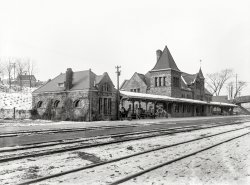
- Coming and Going: 1908
- Circa 1908. "Suburban station, Petoskey, Michigan." Yet another glimpse of this bustling burg. 8x10 inch glass negative, ... Posted by Dave - 08/09/2012 - 1:18pm -
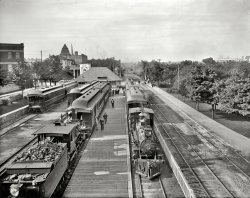
- Heat, Pour, Let Cool: 1901
- Chelsea, Michigan, circa 1901. "Glazier Stove Company molding room." No matter where ... Posted by Dave - 10/20/2012 - 10:52am -
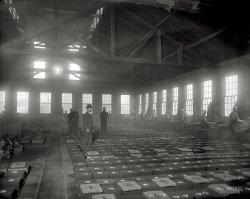
- Main Street USA: 1912
- ... 1912. "Main Street and Chippewa Hotel, Mackinac Island, Michigan." 8x10 inch dry plate glass negative, Detroit Publishing Company. ... Posted by Dave - 07/27/2018 - 1:20pm -
![Main Street USA: 1912 Circa 1912. "Main Street and Chippewa Hotel, Mackinac Island, Michigan." 8x10 inch dry plate glass negative, Detroit Publishing Company. View full size.
+103Below is the same view from August of 2015.
Somewhere in Time!Photo from the very year in which the movie was set.
No luck spotting Elise and Richard, though.
A favorite of the woman who was then my girlfriend, now my wife.
I'd put this earlier than 1912If this were ca. 1912 I think we'd see an automobile or two on the street. Judging by the women's clothes, I'd put it earlier, somewhere 1895-1905.
[You are obviously new to Mackinac Island, famous for being where cars are verboten. Also, count the stars on the flags. There are 48. - Dave]
ColorfulIf this isn't a colorized photo waiting to happen, I don't know what is.
Somewhere elseMackinac Island does feel like it's somewhere (else) in time. It may be because so many of its buildings are still there.
The multi-gabled Chippewa Hotel is on the left, still open every summer. At least the first 4 buildings on the right are still there, but the steeple is gone from the third building.
We remember it fondly because we honeymooned there, well after the season in December; we were the only people in the hotel for a while.
Still smell the horsesNo motorized traffic allowed on Mackinac Island to this day.
What the hackis "bric a brac"?
(The Gallery, DPC, Horses, Stores & Markets)](https://www.shorpy.com/files/images/SHORPY-4a24672a.thumbnail.jpg)
- Hotel Vincent: 1905
- Saginaw, Michigan, circa 1905. "Hotel Vincent." Try our depot shuttle. 8x10 inch dry ... Posted by Dave - 08/14/2012 - 2:10pm -
![Hotel Vincent: 1905 Saginaw, Michigan, circa 1905. "Hotel Vincent." Try our depot shuttle. 8x10 inch dry plate glass negative, Detroit Publishing Company. View full size.
Washington and GermaniaIt appears that (according to the maps and city records) that this hotel stood on the corner of Washington and Germania Avenues. I'm assuming that Germania was changed to Federal due to anti-German sentiment during WWI.
Map showing where the Hotel Vincent Once Stood marked as "1.".
Fire escapesDo those fire escapes have access from a hall, or do you have to break into someone's room to get to one? Given the size of the building, the number of fire escapes reminds me of the lifeboat count on the Titanic.
A Fun Afternoon InvestigationFrom History of Saginaw County we see that the Hotel Vincent was on the corner of Washington and Germania.
Google Maps doesn't show a Germania Street in Saginaw. According to Saginaw: Labor & Leisure it was changed in WWI to Federal Street.
So at the corners of Federal and Washington we see today on Google Maps the remnants of a little building to the right of the Vincent Hotel with the three windows on the third floor. From that, here's what the corner looks like today.
View Larger Map
Re: Fire EscapesAlong with the possible other problems, that last step is a doozy!
French Dry CleaningI thought at first the sign, middle-left, said "French Fry Cleaning" But what the heck is French Dry Cleaning?
[Dry cleaning, or "French dry cleaning," as it was called, is cleaning without water. - Dave]
(The Gallery, DPC)](https://www.shorpy.com/files/images/4a22436a.thumbnail.jpg)
- Charlevoix: 1900
- "Harbor entrance and light house, Charlevoix, Michigan," circa 1900. Detroit Publishing Company glass negative, Library of ... Posted by Dave - 08/20/2012 - 9:53am -
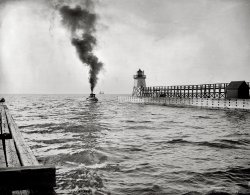
- Star Island House: 1910
- St. Clair Flats, Michigan, circa 1910. "Star Island House." A hotel on the St. Clair River whose ... Posted by Dave - 08/08/2012 - 2:01pm -
![Star Island House: 1910 St. Clair Flats, Michigan, circa 1910. "Star Island House." A hotel on the St. Clair River whose scenic arboreal allée, Willow Avenue, we saw last week. 8x10 inch dry plate glass negative, Detroit Publishing Company. View full size.
Northern hospitalityThey say the St. Clair Flats hotels were popular with Southerners escaping swelter (perhaps looking for a cool-weather counterpart to the Mississippi delta). Whether the lineup on the porch is made up of guests, staff, or some combination thereof, it's the last bunch of folks with whom I'd like to commune with nature.
Those bands on the treesAddressed in this thread.
Your next stop, the Twilight ZoneAnd then all the old people on the porch played Kick the Can, and vanished, as young people.
Hard to FindI was greatly puzzled by this picture and the Willow Ave. picture - where the heck is (or rather was) Star Island? No current maps list Star Island, but I finally found it in an 1895 map from the St. Clair Flats Historical Society. The area is no longer identified as Star Island, and any remnants of the Star Island House and Willow Avenue are long gone.
[See also the maps posted here last week in the comments under the Willow Avenue photo. - Dave]
Good Lord!Charles Addams, please call the office!
(The Gallery, DPC)](https://www.shorpy.com/files/images/4a24386a.thumbnail.jpg)
- Lots of Pulp: 1908
- Circa 1908. "Paper mills at Petoskey, Michigan." 8x10 inch dry plate glass negative, Detroit Publishing Company. ... Posted by Dave - 07/29/2012 - 6:13pm -
